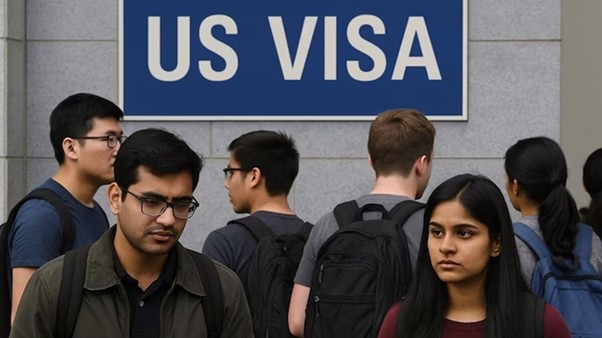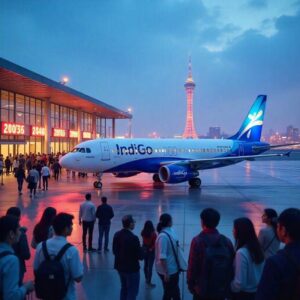It started with India.
In September, student forums lit up with panic when visa queues stretched past the start of semester. Some waited four months just for an interview slot. Others cancelled flights, housing, dreams.
“I’ve done everything right,” one student wrote in frustration on a Chennai WhatsApp group. “Now my future depends on an appointment date.”
Across the ocean, another kind of anxiety brewed. Washington had just rolled out a new $100,000 H1B fee and tightened entry rules. Headlines screamed. Parents worried. Recruiters scrambled.
Meanwhile, in Chengdu, 22-year-old Chen watched the U.S. visa portal crash the day she applied. “It doesn’t feel like something that should happen these days,” she said.
From Mumbai to Manila to Hanoi, Asia’s brightest students are watching the American dream turn bureaucratic. The U.S. visa system, once the world’s fast lane for talent, now feels like a traffic jam.
India: the pipeline under pressure

For years the U.S. higher education and employer ecosystem counted on Indian students to fill vital roles: study, train, work, repeat. But in August 2025, the rhythm broke. Student arrivals from India dropped about 45% from the previous year, a clear sign that the once-steady pipeline is starting to crack.
Why? A few factors:
- The announcement of a new US$100,000 “entry” fee for H-1B visa petitions created panic among students and employers alike. Even though the authorities later clarified that the fee does not apply to F-1 → H-1B status changes for those already in the U.S., the damage to confidence was done.
- The rollback of large-scale interview-waiver schemes for student visas starting October 1 slowed processing and raised uncertainty.
- Entry restrictions for H-1B visa-holders: the new presidential proclamation placed tighter controls on certain non-immigrant workers. Indians feel the blow hardest because they dominate the H-1B cohort.
- Costs, risk and optics: Many students who enrolled assuming a stable visa path now weigh delays that could stretch into months or even complete derailment. The Times of India quotes students saying the process is “very scary now, humiliating even.”
For universities and employers this means the once-steady “India funnel” is no longer guaranteed. For Indian students the stakes feel personal: a family investment, the dream of moving abroad, now clouded by policy shifts.
Our view: this is the moment when the U.S. can either reaffirm its openness or cede ground to alternatives, and for institutions the time to hedge is now.
China: a different lane of disruption

If India’s story is about volume-pipeline risk, China’s is about strategic disruption.
In May 2025 the U.S. announced plans to “aggressively” revoke visas for Chinese students, especially those studying in critical fields or with links to the Chinese Communist Party.
Back in Chengdu, Chen, the same student who watched the visa portal crash in September, said, “It’s pretty absurd. It doesn’t seem like something that should happen these days. If I really can’t go to the U.S., I may take up an offer from the UK’s LSE.”
Another postgraduate student, Lainey (24, Beijing) waiting for her PhD visa: “We feel helpless and unable to do anything … From applying for my PhD until now, this series of visa policies is not very favourable to us.”
What’s happening?
- The U.S. perceives risk: The visa revocations are explicitly linked to “exploitation of U.S. universities,” IP/theft risk, and national-security concerns.
- The effect: Chinese students are deferring, switching destination, or rethinking U.S. options entirely.
- U.S. universities heavily reliant on Chinese enrolments and tuition revenue are suddenly vulnerable.
In short: for Chinese students the pathway is not simply more expensive or slower -it’s uncertain in a foundational way.
Our take: this threatens the brand-appeal of the U.S. in China – and every institution that banks on that appeal must act.
The rest of Asia: under the radar but still shaken

Beyond India and China lies a cluster of emerging student markets: Vietnam, Bangladesh, Nepal, Malaysia, Sri Lanka. They’re less high-profile but vulnerable.
For these students, the visa-interview backlog and increased scrutiny matter. The changes don’t target them specifically, yet the squeeze is real.
One recent article noted that international student arrivals from Asia fell roughly 24 % in August 2025.
Connectivity, deferment, cost-risk – those apply here too. Also, these markets are often the “next rung up” for institutions and employers if India/China options shrink. This means that competition for them will tighten.
Our view: institutions ignoring this region are leaving money and talent on the table.
What universities & employers are doing (or should be)

Shifts like this force three strategic responses: diversify, adapt, communicate.
- Diversify destinations: Schools are accelerating recruitment in markets outside the U.S., or promoting Canada/UK/Europe as alternative options.
- Adapt hiring paths: Employers that counted on the F-1 → OPT → H-1B pathway are now rerouting. They’re looking at remote talent in-country, third-country hires, or local markets entirely.
- Communicate transparently: Students and families crave clarity. The “we’ve always done this” approach no longer passes muster when penalty-fees, delays, revocations dominate the headlines.
If we had to pick one leadership move: begin scenario planning now. Universities and employers need to ask themselves: What if U.S. enrolment from India falls 50 % next year? What if Chinese applications drop another 30 %? What’s our contingency? Institutions and brands must treat this as strategic not operational.
Outlook: next 1-2 admission cycles

What to watch:
- Will the H-1B “entry” fee carve-out remain in place, or will employers still pull back?
- Will U.S. student-visa interview wait times and denial rates improve or worsen? Slow processing may push students to decide earlier in the cycle.
- For China, the key will be transparency. Will Washington reveal how many visas are revoked, and by what criteria? That clarity, or lack of it, will guide how Chinese students and institutions respond.
- For rest of Asia: Watch where students shift – e.g., Canada, UK, Australia, Asian destination universities. Institutions should monitor competitor moves and act fast.
- As students grow uncertain about the U.S. route, universities and employers need to reassess their value proposition. How secure is the visa and work pathway? How high is the perceived risk? And how clearly are those realities being communicated?
In our opinion:
The “American dream” for students from Asia isn’t dead, but it’s no longer the default. Tougher, less predictable, and arguably less welcoming.
For marketers working across global education, talent-mobility and employer-branding this is a turning point. If you treat U.S. policy as a constant, you’ll be behind. This is the moment to adjust.
Turning policy chaos into strategy
If your institution or employer brand serves Asian student/talent pipelines, you’ll want a sharper map of shifting visa dynamics, destination-competition, and recruitment/branding strategy.
Let’s talk. We can help you restructure your messaging, align your offer, and pivot before the next cycle.
In summary
Asian students still dream of studying in the United States, but the path has become steeper. India faces visa delays and policy confusion, China is dealing with targeted scrutiny, and the rest of Asia feels the ripple effect. As costs rise and wait times grow, more families are exploring other destinations. For universities and employers, the smart move now is to diversify, communicate clearly, and plan ahead.




















